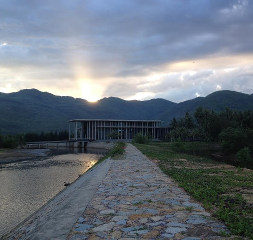Speaker
Description
A photon is a fundamental particle, instead of a nonperturbative composite like hadrons. However, an energetic photon can fluctuate into vector mesons in the kinematic region with a small Bjorken variable x < 0.1. Particularly at x < 0.01, the hadronic contribution to cross sections of the electron–photon deep inelastic scattering dominates, and a photon can be regarded as a hadron rather than a pointlike object. Therefore, effective models are needed for studies of the photon structure in this region. We present analysis on the photon structure functions at small x in the framework of the holographic QCD, assuming dominance of the Pomeron exchange. The quasi-real photon structure functions are expressed as convolution of the Brower–Polchinski–Strassler–Tan (BPST) Pomeron exchange kernel and the known wave functions of the U(1) vector field in the five-dimensional AdS space, in which the adjustable parameters in the BPST kernel have been fixed in previous studies of the nucleon structure functions. The predicted photon structure functions, as confronted with experimental data, provide a clean test of the BPST kernel. The agreement between theoretical predictions and data is demonstrated, which supports applications of holographic QCD to hadronic processes in the nonperturbative region. Our calculations are also consistent with those derived from the parton distribution functions of the photon proposed by Glück, Reya, and Schienbein, implying realization of the vector meson dominance in the present model setup. Our results presented in this talk will be tested at future linear colliders, e.g., the planned International Linear Collider.
